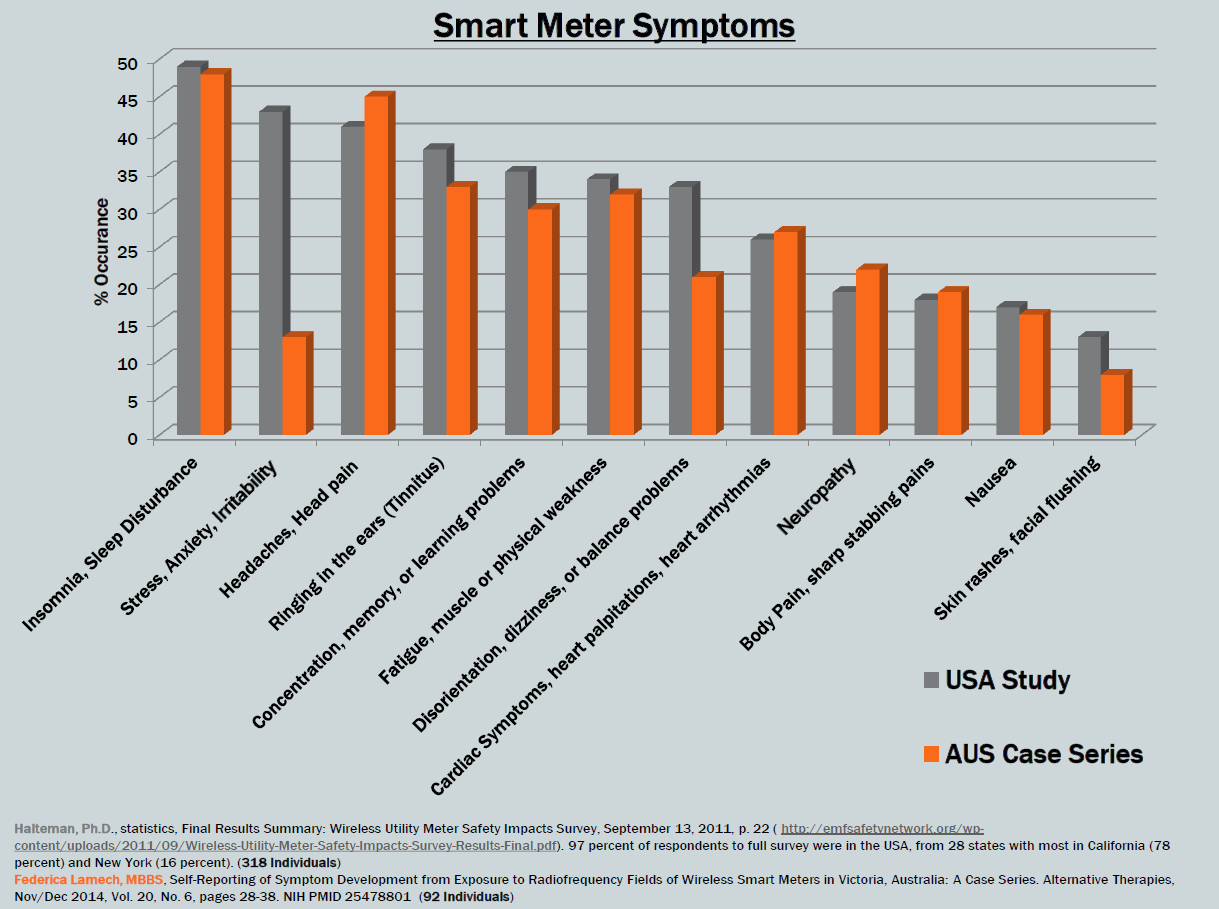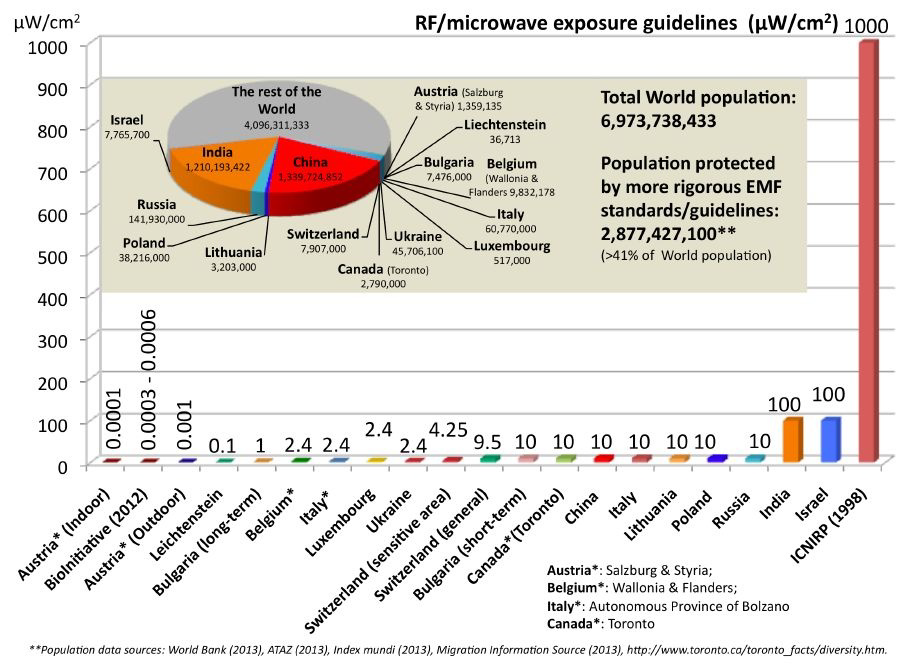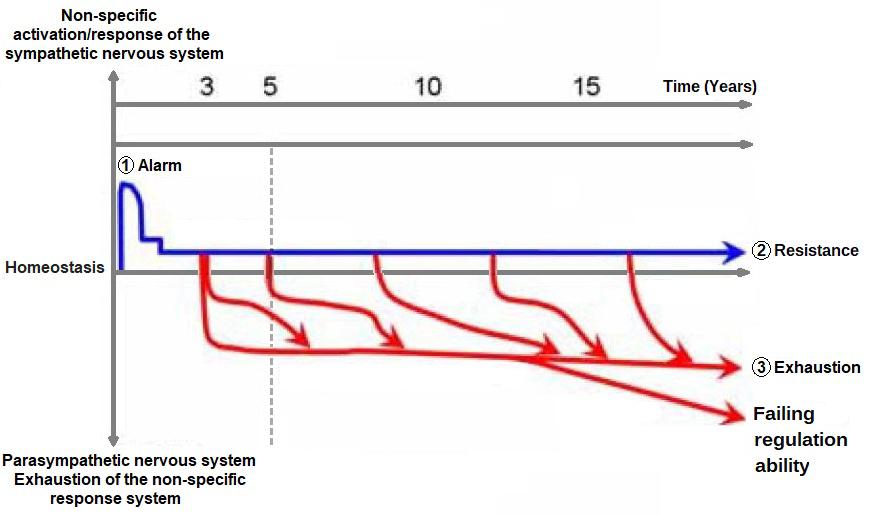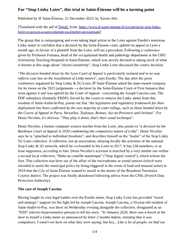In my last reply to my previous EngX discussion Severe Tinnitus Following the Installation of New Electricity Meters, which is still attracting a lot of viewings over a year on, I stated that my hunt would continue for medical and electrical answers as to why I had suffered bad health reactions including; tinnitus, insomnia, chronic fatigue, migraine, tingles and twitches, sore eyes, sinus problems, blood pressure problems and several other symptoms, during a 197 day ordeal while my home was fitted with a series of 5 digital electricity meters. To some extent, it still remains work in progress, there's a few pieces of the jigsaw to find, but having already found some very concerning science about non‑ionising radiation, how protection from it is regulated and plenty of evidence of others suffering similarly, it is time for an update:
The suspicion that switched-mode power supplies (SMPS) without noise suppression as used by digital electricity meters affected my health has to be valid as all my symptoms considerably improved within 7 days of the traditional electro-mechanical meter being fitted, almost all to the point where they were no longer noticeable. The peaks of electrical noise I found using the FFT function on my oscilloscope prior to fitting this meter on the mains wiring within my home were no longer present. I felt I had been given my life back and I remain grateful to my energy supplier for eventually fulfilling my ever increasingly desperate requests to have such a meter reinstalled.
Unfortunately the 197 day ordeal endured has left its mark and, as many other sufferers have reported, the longer you are exposed to what is causing the health reactions, the more difficult it is to return back to normal. Tinnitus lingers on - unless I am away from my home and other places that seem to still stimulate it. (ie It remains an environmental problem.) What I haven’t had to do since 25 August last year is to abandon my house for respite or sleep out in the garden, as I did so many times during my ordeal.
I have found science indicating that I was not far out with the notion of ultrasonics playing a role in the tinnitus, but rather than acoustics, it is electromagnetic fields oscillating in the ultrasonic range as a consequence of “dirty electricity” - extraneous frequencies on the AC mains in the tens and hundreds of kilohertz. Within human and many other animal ears (this isn’t just a human problem), the tectorial membrane coating hairs in the cochlea and the otoconia in the saccule are piezoelectric. As a result they will convert electric currents arising from ultrasonic frequencies of electric and electromagnetic fields into sound. The auditory nerve itself can be electrically stimulated. The result is that the human ear may be 5,000 to 10,000 times more sensitive to electric and electromagnetic fields oscillating at ultrasonic frequencies than at power line frequencies. The resulting sound is apparently filtered out my most people by their brains, but some people end up hearing a high pitched tinnitus tone close to the top of their hearing range. Resonance is an important factor on sustaining the effect and for starting it in the first place where field strengths are low. This all seems to fit so very closely with my own suffering of a high pitched tone close to the top of my hearing range.
There are also many other mechanisms for interference within the human body by electromagnetic fields. For example; generation of reactive oxygen species (ROS), increased free radical production and activation of voltage-gated calcium channels. These lead to oxidative stress and then all sorts of symptoms can arise including those I experienced last year, as shown in the diagram below:

As I reported in my original discussion, I am far from alone, finding others reporting similar symptoms to myself is quite easy to achieve. Surveys were carried out years ago when people started complaining of health impacts after meters started to be fitted in homes. Here’s a chart from a study of people who complained of health ailments in Australia and the USA after having smart meters fitted in their homes (Source: Steve Weller, 2015. The Biological Effects of Electromagnetic Radiation. 10.13140/RG.2.2.28585.47205.):

The first six of these symptoms figured highly in the period that I had digital meters installed in my home, plus one of the other symptoms. These symptoms, and those in the previous diagram, come up time and time again in reports from others on the ailments people experience in their homes after having had smart meters fitted. If you don’t believe me, then try searching online yourself, it shouldn’t take you very long to find them.
There is plenty of science to substantiate that harm is being done by exposure to man-made electromagnetic radiation. Over 100,000 peer reviewed scientific papers have been published. You can find more than 40,000 such publications and over 7,000 summaries of individual scientific studies at the “The EMF Portal”.
Unfortunately despite all the science and reports of people suffering the same set of symptoms, regulators do not want to admit there are any harmful effects from relatively low levels of man‑made electromagnetic radiation. Politicians do not understand what is happening to people and the environment as a consequence of something that is an invisible problem to all except the scientists working on the matter and those knowingly affected. The politicians refer to the regulators for advice and as they are not going to admit there is a problem with their own guidance, their reply always is; “there is no problem, everything is safe as the exposure is below the ICNIRP limits”. Any individuals complaining that there is a problem are then told they are the first to ever complain, nothing is wrong, despite many complaints previously going back well over a decade.
There are many scientists and campaigners calling for changes to how exposure limits are regulated and a search on the Internet will reveal immense dissatisfaction with the guidelines from the ICNIRP, the WHO’s “The International EMF Project” and other related radiation protection bodies through their stubbornness in not accepting any of the science that reveals harmful effects other than heating, despite another part of WHO declaring Electromagnetic Fields a “Class 2B possible carcinogen”. (See: https://www.iarc.who.int/wp-content/uploads/2018/07/pr208_E.pdf) In 2021 a group of scientists, doctors and related professionals whose work and warnings on the effects of non-ionising radiation were constantly being ignored, set up the “International Commission on the Biological Effects of Electromagnetic Fields” with the aim of providing independent recommendations on exposure limits that do protect the public and the environment. (See: https://icbe-emf.org/)
There are problems not just with the magnitude of the limits currently imposed but also how radiation intensity is measured. For example, strong pulses of radiation are averaged out over a comparatively large timescale that reduces the intensity to a negligible amount when compared to the limit, but the pulse itself could have been above the limit for an instant and/or strong enough to create a shock-wave within the bioelectrical systems of the human body. Frequency as well as the intensity of the radiation is also a significant factor, certain frequencies at a low intensity can cause more effects than other frequencies at much higher intensities.
The ICNIRP, despite refusing to accept any science revealing harmful effects other than heating injury, states in its guidance for low frequencies (LF), the range that I believe had a significant detrimental affect on my health:
“When people are exposed to LF fields, electric fields and currents are generated inside the body and they can interfere with the body’s own electric fields and current flows related to normal biological functioning.”
(From: https://www.icnirp.org/en/frequencies/low-frequency/index.html)
What follows this statement are remarks about the effects being mainly unnoticed, temporary and inconsequential. This is not something I will ever concur with as my health so badly compromised last year. There is also a statement that high exposures can cause permanent irreversible cardio-vascular effects. Common effects reported for low exposure to frequencies caused by dirty electricity include; cardio vascular problems. Scarily, investigations into links with Alzheimer’s and ALS/MND are mentioned as being “inconclusive”, as are insomnia and cognitive functioning. I can vouch for the latter pair of ailments, I hope I never have to vouch for the former pair. There is also scientific evidence on childhood leukaemia resulting from exposure to high tension power lines, yet the ICNIRP state there is no proof of any such causation.
Despite requests, Russia refuses to follow the ICNIRP guidelines due to research it carried out during the Soviet era and remains alarmed that the West hasn’t heeded the science it shared some years ago. It sets its limits for levels of exposure at just 1% of the ICNIRP levels, as does China and many former Soviet and Eastern Bloc States. Here’s a comparison albeit these are limits applying for microwave frequency exposure (Source Jamieson, I. 2014: RF / Microwave Radiation Risk Awareness, Figure 1):

As you can see, some countries and regions in Western Europe take the matter even more seriously than Russia and China.
While not adopting stricter exposure limits yet, Sweden acknowledges the existence of electro‑hypersensitivity as a “functional impairment disability” with around 3.2% of the population already identified as sufferers. (Sweden is not alone in the recognition of EHS.) This would equate to over 2 million people in the UK. Some estimates of electro-hypersensitivity put the percentage at 12%, the median value seems to be between 5% and 6%, roughly equating to 3.5 million people in the UK. Note the charity ES-UK states that around 50% of the population will notice some sort of effect(s) and the rest don’t escape, they just won’t notice how they are being affected.
Thanks to the lead times in symptoms appearing and the medical profession having had no training to spot causation of symptoms via electro-hypersensitivity, cases are not being recorded and we simply do not know just how big the problem currently is in the UK. People who suspect they have symptoms due to an electrical device being installed in or near their home will be told it is simply nonsense. However, there are statistics for the related symptoms of tinnitus, insomnia, chronic fatigue, migraines and ADHD and many others indicating that these are all on the rise within the population, some rising as a percentage very quickly indeed. However, it seems no one in the NHS wants to take notice into the research pointing out these as symptoms of electromagnetic radiation exposure. My GPs are interested but say they don’t have time to look into the matter. Meanwhile, the pressure on their already stretched services for treatment regarding these ailments continues to increase.
One of the remaining questions I haven’t found any answers for yet is: “Why I am so different to have become hypersensitive before most others?” I don’t particularly feel special in any way, I might have more amalgam fillings than I would like (some people cite these as aiding and abetting such sensitivity but my dentist doesn’t see it as a worthwhile reason to go to the trouble of replacing them) and I’ve also had quite a few MRI scans in my time. However, I simply haven’t been able to establish any commonalities with other sufferers. Hence I can't state who will be vulnerable to this problem. I had no idea I would ever suffer like I did last year, I put my trust in the people who authoritatively stated there was nothing to be concerned about. They may easily be the next to suffer.
We all are electrical beings, animals and plants too. All are dead without internal electrical activity and all respond to electromagnetic fields, some at very low levels of intensity, birds for navigation as an example. (There are many scientific papers concerning effects on birds, bees and trees.) It appears that we all have our own individual threshold of tolerating interference from non‑ionising radiation. The diagram below was originally produced in Germany by Professor Karl Hecht in 2016, which depicts the different stages of coping:

The timescales involved are rather long, the human body can put up with so much, but at some point, failure to cope will occur. The timeline in the diagram is actually just an example to show how long the process can take and that’s one of the reasons EHS is so complicated to define as a causation of ill health. The other is that oxidative stress is caused by other things in our modern day lives. Ultra Processed Foods (UPFs) for example, which are facing similar complaints of ill health from scientists, while the government advice comes from people associated with the very industry producing UPFs and promoting them as being good for us. Check out the health data panel on the side of a can of diet cola for example. You might decide it's so healthy you want to drink nothing else. (Please don’t reply about that.)
Just over a year ago, I made contact the lead author of "Dirty power from new electricity meters: Key to a health problem?” (Please note links within this document have been fixed since the document was uploaded in my previous discussion). This document contains information on SMPS in electricity meters leading to tinnitus, insomnia, concentration problems, fatigue and joint pain. He pointed me to two books he and his co-authors had written on the entire subject of how ill health can result from smart and dumb electricity meters, but written in Norwegian. These books have since been fully translated into English, they include the above diagrams and much more of the science surrounding them. They are free to download from the author’s website:
https://einarflydal.com/sdm_downloads/download-smartmeters-dirty-electricity-pulses-and-health-pdf/

https://einarflydal.com/sdm_downloads/download-smart-meters-the-law-and-health-pdf/
Both books were originally written before my ordeal with digital meters began. “Smart meters, dirty electricity, pulses and health” is the most recent of the books and has had some updates during its translation. It provides quite a comprehensive view of the whole subject of health related problems arising from non-ionising radiation emitted by electricity meters plus other devices/equipment.
“Smart meters, the law and health” is more or less a direct translation of the Norwegian version with a few notes containing updated information. Part 1 of this book concerns the law in Norway, where smart meters were made mandatory, and the law concerning the European Convention on Human Rights. The Annexe, Part 2, is the forerunner of the other more recent book, but it contains some interesting additional details including how the ICNIRP and “The International EMF Project” were founded and how they operate to maintain the “thermal paradigm” that only heating effects need to be prevented. This book was originally published in 2018 and in the conclusion to Part 2, the author made this rather interesting prediction:
“From around 2022, there will be a tipping point in health statistics. From around 2025 it should be possible to observe that from 2022 there has been a growth in general morbidity, and the increase in morbidity will be steeper in the following 10-15 years. Some – the “electrically insensitive” – who in number are perhaps as numerous as the electrically hypersensitive – will go completely free.
The most common symptoms will be neuro-vegetative disturbances such as neuroses, depression, fatigue during the daytime, performance impairment, sleep problems, headaches, various changes in heart/vascular functions, hyperactivity, cardiac arrhythmia, tinnitus and inner restlessness.”
How true this prediction came for me in 2022. As for the prediction for the period 2025 to 2040 about increasing morbidity, a few months ago “The Health Foundation” made exactly the same prediction about increasing morbidity: 2.5 million more people in england projected to be living with major illness by 2040. The illnesses it cites as causing the rise in morbidity are; anxiety and depression, chronic pain and diabetes. Sifting through the research papers, these conditions come up time and again as long term problems with links to overexposure to non-ionising radiation, plus lots more of concern too. (For a lengthy list of possible effects and ailments, please see section 14 within “Selected Studies on Electrosensitivity (ES) and Electromagnetic Hyper-sensitivity (EHS)”.)
It is of no surprise that the Norwegian books take aim at the ICNIRP and the related WHO’s “The International EMF Project”. The books describe how the science presented to these organisations is sifted and rebuffed, but rather than disagreeing outright when harm is difficult to deny, they send it back to the authors with a note stating; “further research required”. How they deliberately ignore the precautionary and “ALARA” (As Low As Reasonably Achievable) principles in the face of science showing there are problems is also explained, and that recklessness should be worrying to all of us, not just to the people who have become affected already.
If you still don’t want to believe these books and all the science they reference, nor what happened to myself, just try searching the Internet for “dirty electricity” and “smart meters tinnitus” and you will receive plenty of results. There’ll be a few weird and wonderful websites returned among the results, but I scanned through the top 1,000 results for “dirty electricity” very recently and found only a few results that were off topic. Most of the results appeared to be reporting very similar things about the technologies that cause it and the symptoms being suffered.
What is also highly noticeable in all the searching online I’ve been doing, is the absence of any viable alternative to explain how I became so ill last year nor any science attempting to prove the human body is 100% compatible with man-made electromagnetic radiation (up to the point at which heating injuries occur). There are scientific reports that low levels of interference can actually make improvements to health in certain circumstances. Recently BBC Click on 7 October featured the Nissan Formula E racing team drivers being subjected to low levels of electromagnetic radiation in order to stimulate their brains in seemingly successful attempts to improve their reaction speeds and alleviate insomnia due to jet lag. There’s plenty of other science too on positive effects, but you can’t accept there are no effects if you want to accept that there are good effects.
While dirty electricity can be produced by many appliances, and very worryingly many are devices that are being promoted as saving the environment, what can be done with reference to electricity meters? Most importantly, they need to include electrical noise suppression to stop their power supplies creating and spreading dirty electricity around the home and the local neighbourhood. Next, why can’t they use the home’s broadband router (with VOIP telephony being rapidly rolled-out, almost every home in the UK will have one soon) to return data to the energy companies rather than putting in another wi-fi router and what is essentially a mobile phone that makes a call at least once every 30 mins 24/7? As for the in‑home display unit, why not an app for the computer or phone? I’m finding a lot of people throw these displays in a drawer thinking that this the smart meter and then claim they don’t have one! For those who have wi-fi intolerance (a co-author of the Norwegian books is one such person), then how about an Ethernet socket so that a cable can be run between the meters and to the home’s broadband router? There’s certainly no need for mobile phone communication, which is such a bugbear for many smart meters already installed and now to the mobile phone industry who are having to keep the second generation of mobile phone systems running longer than ought to have been necessary.
As for ES/EHS sufferers; what I’ve found is that they are living in an absolute nightmare situation. People are suffering, very very badly in some cases, from something that others do not want to believe exists. Appropriate help is near impossible to obtain from the authorities and the medical profession, allowing their suffering to continue and worsen with time. (I even had treatments for an unrelated problem withdrawn due to my physical condition deteriorating so much.) Then they have to suffer the taunts of delusion, of psychological causation, despite all the peer reviewed science readily available and the commonality of symptoms reported by sufferers around the world over many years, many of whom were blind to the problem before they started suffering symptoms, myself included. Even so, the result is not the compassionate care that befits anyone suffering mental illness, it is more akin to the treatment lepers received in bygone centuries; sufferers are shunned and made outcasts from ordinary society. Those like myself who find themselves sensitive to digital electricity meters, are told to live with the meter causing them harm or have the electricity turned off. Anyone wondering what the latter is like, just turn your electricity off and see how long you last before craving to turn it back on. Some ES/EHS sufferers retreat to living off-grid in the wilderness to try to escape the technologies hurting them and the people deriding them. The way sufferers are treated can result in extreme mental anguish, serious anxiety and depression can set in. Suicides are not unknown.
This is not the treatment any minority deserves in the 21st Century, certainly not one that is trying its best to stop others from following in their wake by raising the alarm about what is happening to them and the environment as a whole. Without recognition, independent regulation and engineering solutions, this problem is soon going to become a lot lot worse as we rush into electrifying almost everything in our lives. I’ve had a preview of the future and if nothing changes, it’s going to be far from an environmentally friendly and healthy place. For many it will be a very dark place indeed.

